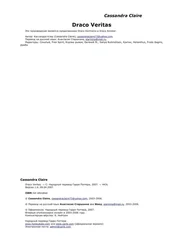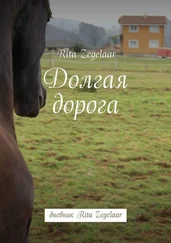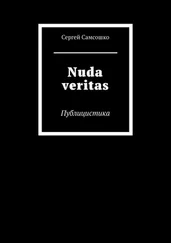Rita Monaldi - Veritas
Здесь есть возможность читать онлайн «Rita Monaldi - Veritas» весь текст электронной книги совершенно бесплатно (целиком полную версию без сокращений). В некоторых случаях можно слушать аудио, скачать через торрент в формате fb2 и присутствует краткое содержание. Жанр: Исторический детектив, на английском языке. Описание произведения, (предисловие) а так же отзывы посетителей доступны на портале библиотеки ЛибКат.
- Название:Veritas
- Автор:
- Жанр:
- Год:неизвестен
- ISBN:нет данных
- Рейтинг книги:3 / 5. Голосов: 1
-
Избранное:Добавить в избранное
- Отзывы:
-
Ваша оценка:
- 60
- 1
- 2
- 3
- 4
- 5
Veritas: краткое содержание, описание и аннотация
Предлагаем к чтению аннотацию, описание, краткое содержание или предисловие (зависит от того, что написал сам автор книги «Veritas»). Если вы не нашли необходимую информацию о книге — напишите в комментариях, мы постараемся отыскать её.
Veritas — читать онлайн бесплатно полную книгу (весь текст) целиком
Ниже представлен текст книги, разбитый по страницам. Система сохранения места последней прочитанной страницы, позволяет с удобством читать онлайн бесплатно книгу «Veritas», без необходимости каждый раз заново искать на чём Вы остановились. Поставьте закладку, и сможете в любой момент перейти на страницу, на которой закончили чтение.
Интервал:
Закладка:
The information on other Italian musicians in Vienna is taken not only from the Viennese archives but also from L. Ritter von Köchel, Die Kaiserliche Hof-Musikkapelle in Wien 1543–1867 , Vienna 1869, and B. Garvey Jackson, “Oratorios by Command of the Emperor: The Music of Camilla de Rossi”, in Current Musicology , 42 (1986), p. 7. Gaetano Orsini really did sing for Camilla de’ Rossi’s oratorios, and was among the musicians who received payments from Joseph’s secret coffers (cf. Vienna State Archive, Hofkammerarchiv, Geheime Kammerzahlamtrechnungen 1705–1713, varii loci , ad es. c.10v).
The convent of Porta Coeli really did exist. Unfortunately it was demolished by order of Emperor Joseph II in 1785, along with many other convents in the city. The archive of Porta Coeli, which survived the demolition, is kept at the Vienna City Archive.
The story narrated on the fourth day by Camilla of the Turkish slave girl assigned to the novitiate at Porta Coeli and rejected by the other nuns is also authentic. Cf. P. Alfons Žák, “Das Frauenkloster Himmelpforte in Wien”, in Jahrbuch für Landeskunde von Niederösterreich , new series, VI, (1907), Vienna 1908, p. 164: “In the year 1695 a Turkish slave girl of Gerolamo Giudici, the Spanish lieutenant of Cardinal Leopold Count Collonitz, was baptised at Saint Ursula, and she was to be educated at the convent of Himmelpforte. The nuns protested against the arrival of the girl, since they were all noble novices, while she was a slave. Even the Kaiser agreed with them, on 3rd September 1695, and after the lieutenant applied to the Viennese consistory on 12th September, requesting them to oblige the convent to take the slave into the novitiate, on 16th September, the request was turned down.”
Nor should the sudden appearance of Camilla de’ Rossi in the buttery near Neugebäude occasion any surprise: the convent of Porta Coeli did in fact possess some properties near the Place with No Name, as is attested by the documents concerning the convent held at the Vienna City Archive.
It is quite plausible that Camilla de’ Rossi should have retired to the convent of St Lawrence. This is not only because it is impossible to find any trace of the musician after 1711, either in Vienna or in her native Rome, but also due to a surprising account given by Lady Montagu, the famous English writer and traveller, who, visiting the capital of the Empire in 1716, writes:
I was surprized to see here the only beautiful young woman I have seen at Vienna, and not only beautiful, but genteel, witty and agreeable, of a great family, and who had been the admiration of the town. I could not forbear shewing my surprize at seeing a nun like her. She made me a thousand obliging compliments, and desired me to come often. It would be an infinite pleasure to me, said she sighing, but I avoid, with the greatest care, seeing any of my former acquaintance; and, whenever they come to our convent, I lock myself in my cell. I observed tears come into her eyes, which touched me extremely, and I began to talk to her in that strain of tender pity she inspired me with; but she would not own to me that she is not perfectly happy. I have since endeavoured to learn the real cause of her retirement, without being able to get any other account, but that every body was surprized at it, and no body guessed the reason. I have been several times to see her; but it gives me too much melancholy to see so agreeable a young creature buried alive .
( Letters of Lady Mary Wortley Montague: Written During Her Travels in Europe, Asia, and Africa, to which are Added Poems by the Same Author . Paris 1822, pp. 37–38).
The therapies used by Camilla de’ Rossi, based on the medicine of St Hildehard of Bingen, are all authentic. There is nothing surprising in the fact that the Chormaisterin learned these skills from her Turkish mother: as Karl Heinz Reger ( Hildegard Medizin , Monaco 1989, p. 11) reports, some scholars see clear influences of Islamic culture on Hildegard’s writings.
Ottoman Customs, Embassies and Legends
All the descriptions that Cloridia gives of Ottoman customs, such as the particular concept of hospitality (the guest as muzafir ), Populescu’s account of the harem, the dervish’s ritual, the Armenian use of the tandur , Atto Melani’s descriptions of the derebeys and the rebels of Giaur-Daghda, including his reflections on “men without a conscience”, faithfully reflect the accounts given by contemporary travellers visiting the Ottoman Empire and their scandalised reactions to customs and ways of thinking that were so different from those in the West. See, for example, Maccari, Diario del mio viaggio di Costantinopoli presentato alla Maestà dell’Imperatore Leopoldo I , Ms., 67 cc. This is a stupendous manuscript in Italian, kept in the manuscript collection of the National Library of Vienna, which the authors will publish in the near future.
Accounts of the Ottoman Empire remained practically unchanged from the sixteenth to the nineteenth century. See, for example, Ferriol, Wahreste und neueste Abbildung des Türckischen Hofes. . 1708, 1709 . ., Nuremberg, 1719; and the Piedmontese princess Cristina di Belgioioso, “La vie intime et la vie nomade en Orient”, Revue des Deux Mondes , 1855. Belgioioso, among other things, describes how she herself witnessed the magic dancing ritual of dervishes, who made cuts all over their bodies which then inexplicably healed within a few seconds, just as described by the chimney-sweep.
During our research in Istanbul we had the good (and ill) fortune to track down, at an antiquarian’s in the Grand Bazaar, the disjecta membra of a Venetian diary on Constantinople from the end of the sixteenth century; unfortunately the antiquarian had already stripped it of its cover and frontispiece, and had cut out all the individual pages in order to sell the engravings for 150 euros each. This kind of malpractice is, alas, common among antiquarians throughout the world; to our way of thinking, it should be severely punished by the law. Yielding to our heartfelt supplications, the antiquarian courteously allowed us a rapid examination of the fragmentary writings on the back of the engravings.
The Turkish legends that the students investigate (principally, that of the golden apple and the forty thousand of Kasim) are all genuine; they are reported, for example, by Richard F. Kreutel (ed.), Im Reiche des Goldenen Apfels. Des türkischen Weltenbummlers Evliyâ Çelebi denkwürdige Reise in das Giaurenland und in die Stadt und Festung Wien anno 1665 , Graz-Vienna-Cologne, 1957.
The myth of Dayı Çerkes, or Dayı Circasso, recounted by Penicek, corresponds to the version provided by Kerstin Tomenendal, Das türkische Gesicht Wiens , Vienna-Cologne-Weimar 1999, p. 187 ff. The Turkish version of the legend is narrated in the excited travel account of the Turk Evliyâ Çelebi, who visited Vienna in 1665. The statue can still be admired on the façade of the palace. The address is: Heidenschuss 3.
Equally true is the inhuman practice of the kidnapping of Christian children by the Ottomans that Atto Melani describes. Robert Mantran discusses it in La vita quotidiana a Costantinopoli ai tempi di Solimano il Magnifico , Milan 1985 (original edition: Paris 1965), pp. 104–105:
After the second half of the fourteenth century, which is to say, after the conquest of a part of Balkan Europe, the Ottomans, in order to ensure the regular recruiting of an army that was expanding in strength and size, used a system that profoundly disturbed Christian consciences but which for a long period of time proved of great service to the Turks: we allude to the dev irme, the “harvest”. This system consisted of the annual or biannual culling, in a certain number of Christian families of the Balkans, of male children under the age of five. Separated completely from their parents, these children were sent to Anatolia, to Muslim families where they were brought up in the Muslim fashion, taught Turkish and initiated into Turkish and Islamic habits and traditions. At the age of ten or eleven they entered the educational institutions of the palaces of Hadrianopolis and Gallipoli and, after the conquest, Istanbul, and from this moment on they were termed acemi o lan. Depending on their aptitude they were sent to the army or to the palace, where they became pages and were termed iç o lan. There then followed a procedure that saw them rise from rank to rank, and if they succeeded in attracting the attention of the sultan or of a sultana or of some favourite, there was nothing to stop them from gaining access to the highest offices, even that of Grand Vizier. Having practically forgotten their origins and owing their own position solely to the favour of the sultan they showed him the utmost devotion and had no other ambition than to devote themselves to his service .
Читать дальшеИнтервал:
Закладка:
Похожие книги на «Veritas»
Представляем Вашему вниманию похожие книги на «Veritas» списком для выбора. Мы отобрали схожую по названию и смыслу литературу в надежде предоставить читателям больше вариантов отыскать новые, интересные, ещё непрочитанные произведения.
Обсуждение, отзывы о книге «Veritas» и просто собственные мнения читателей. Оставьте ваши комментарии, напишите, что Вы думаете о произведении, его смысле или главных героях. Укажите что конкретно понравилось, а что нет, и почему Вы так считаете.











